

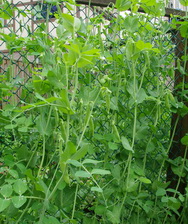
New flavours, new blooms, new tastes, the summer garden is coming in to its own and paying huge dividends for all of the effort that is poured into it during the early spring. We are barely getting used to the crunchy goodness of the Pak Choi when the sweet taste of the first peas rolls across our plate. Well the first peas never actually see a plate; they get consumed right where I find them in the garden. The Sugar Snap Peas are rapidly filling out and should be ready for dinner by the end of the week.The Morning Glories are now racing the Pole Beans up their strings after I spent a moment showing them where those strings were. 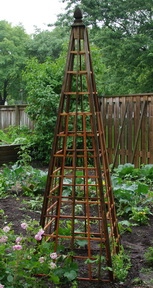 Nothing lasts forever. The obelisks that are home to my Cucumbers are somehow falling apart and they are only about twelve years old. The Cucumbers and a few Sweet Peas are already planted in a square that is the size and shape of the obelisk. That forced me back into the carpentry business and one of the rebuilt structures was placed between the rapidly growing vines yesterday. A moment spent with each vine showing it where it was supposed to grow and we are well on our way to another large and successful crop of vertical Cucumbers. I need to have the same conversation with the various Melon vines that are wandering around looking for the length of hardware cloth that they are supposed to be scrambling up.
Nothing lasts forever. The obelisks that are home to my Cucumbers are somehow falling apart and they are only about twelve years old. The Cucumbers and a few Sweet Peas are already planted in a square that is the size and shape of the obelisk. That forced me back into the carpentry business and one of the rebuilt structures was placed between the rapidly growing vines yesterday. A moment spent with each vine showing it where it was supposed to grow and we are well on our way to another large and successful crop of vertical Cucumbers. I need to have the same conversation with the various Melon vines that are wandering around looking for the length of hardware cloth that they are supposed to be scrambling up. 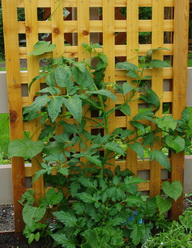 The new trellises in the front yard are slowly getting covered with the variety of plants that were put in front of them. The large Tomato plants that were part of the Loblaw’s Gigantico program have been tied back to these trellis and are developing fruit well ahead of my own regular plants on the Tomato structure in the back garden. It does take a little more effort to grow the Tomatoes tied to a trellis than simply twining around a rope but it may look a little nicer in the front yard. The plants want to grow away from the trellis because there is more light coming to them from the other side.
The new trellises in the front yard are slowly getting covered with the variety of plants that were put in front of them. The large Tomato plants that were part of the Loblaw’s Gigantico program have been tied back to these trellis and are developing fruit well ahead of my own regular plants on the Tomato structure in the back garden. It does take a little more effort to grow the Tomatoes tied to a trellis than simply twining around a rope but it may look a little nicer in the front yard. The plants want to grow away from the trellis because there is more light coming to them from the other side.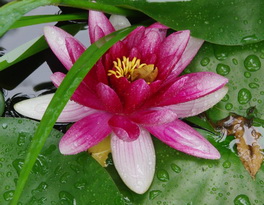 The ponds are exhibiting their usual behaviour. Lilies grow reasonably well in a pot for the first year or two and then really slow down. A piece of lily root eventually makes it into the muck at the bottom of the pond and then with it’s roots unrestricted it grows and flowers with great vigour. This response would seem to indicate that I should just give up on pots but then how do I clean the ponds out. The solution is to only clean the ponds every few years. They do accumulate a great deal of debris from the overhanging Walnut tree and must eventually be cleaned. The roots of Lilies and other plants growing in muck at the bottom of the ponds does help to reduce the muck and to remove nutrients from it. A natural cycle of debris, plants and fish can theoretically be established that should keep the ponds functioning well for a number of years. I think I’m getting there as the pond water is clearer this year than in previous years and I only have a small passive filter at the bottom of one of the waterfalls.
The ponds are exhibiting their usual behaviour. Lilies grow reasonably well in a pot for the first year or two and then really slow down. A piece of lily root eventually makes it into the muck at the bottom of the pond and then with it’s roots unrestricted it grows and flowers with great vigour. This response would seem to indicate that I should just give up on pots but then how do I clean the ponds out. The solution is to only clean the ponds every few years. They do accumulate a great deal of debris from the overhanging Walnut tree and must eventually be cleaned. The roots of Lilies and other plants growing in muck at the bottom of the ponds does help to reduce the muck and to remove nutrients from it. A natural cycle of debris, plants and fish can theoretically be established that should keep the ponds functioning well for a number of years. I think I’m getting there as the pond water is clearer this year than in previous years and I only have a small passive filter at the bottom of one of the waterfalls. 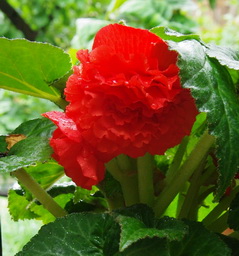 The Tuberous Begonias that decorate the pillars surrounding our deck have started to bloom. It’s time to remember that each set of blooms on most of these plants will have two small female flowers and one large male flower. Removal, as early as possible, of the smaller female flowers will increase the size of the remaining male flower. It sounds very sexist but it works. The female flowers are identified by a triangular ovary that is obvious behind the row of coloured petals. Just pinch out the ovary and flower and be careful not to break off the desired male flower. You will curse loudly when you do and hopefully will learn how to execute this simple, if somewhat delicate, task.
The Tuberous Begonias that decorate the pillars surrounding our deck have started to bloom. It’s time to remember that each set of blooms on most of these plants will have two small female flowers and one large male flower. Removal, as early as possible, of the smaller female flowers will increase the size of the remaining male flower. It sounds very sexist but it works. The female flowers are identified by a triangular ovary that is obvious behind the row of coloured petals. Just pinch out the ovary and flower and be careful not to break off the desired male flower. You will curse loudly when you do and hopefully will learn how to execute this simple, if somewhat delicate, task.The time spent in the garden as summer opens up doesn’t diminish but some of the urgency dissipates. Each morning’s wonderful wander around the paths and through the beds becomes less of a review of what needs to be done and more of an appreciation of the beautiful bounty that is bursting forth from the soil. Yes, that’s why we do it! 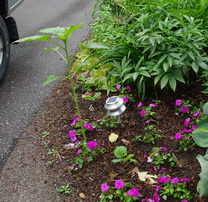
Marina &Jim ask? Ken...how and when do we prune our two year old quince bush? It has reddish yellow blooms on it and is only about one meter high. Thanks. By the way, love your Dallying in the Dirt.. |
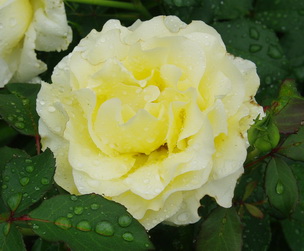 The early warm weather has somehow produced the best Rose blooms that we have seen in a long time. They are big and fragrant and wonderfully free of insects and diseases. Of course the first flush of those magnificent blooms is almost finished and the local Rose Show is today. I may be able to find a few fading blooms to enter. Needless to say a fine crop of natural vegetation (aka. Weeds,) is also flourishing in all parts of the garden.
The early warm weather has somehow produced the best Rose blooms that we have seen in a long time. They are big and fragrant and wonderfully free of insects and diseases. Of course the first flush of those magnificent blooms is almost finished and the local Rose Show is today. I may be able to find a few fading blooms to enter. Needless to say a fine crop of natural vegetation (aka. Weeds,) is also flourishing in all parts of the garden.